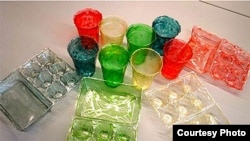A substance found in the shells crustaceans and parts of insects could provide the world with an abundant and environmentally friendly way to replace many plastics.
It’s called chitosan, a resilient form of chitin, which researchers at Harvard’s Wyss Institute for Biologically Inspired Engineering say is the “the second-most abundant organic material on Earth.”
Chitin is a tough polysaccharide found in the shells of crustaceans.
After Wyss announced its progress making chitosan-based materials in March, they were approached by a variety of companies and entrepreneurs eager to learn about it and explore possible commercial uses, said Javier Fernandez, a lead researcher on the project.
One example, a simple drinking cup, could be made from about 200 grams of shrimp shells, about a handful, Fernandez said.
To put that in perspective, Fernandez said that one species of plankton-sized crustaceans, the copepod, is estimated to produce billions of tons of chitin each year.
“That means that they have produced in the last 12 months roughly the same amount of chitin than the worldwide plastic production since 2009,” he said in an email.
According to the Wyss Institute, humans manufacture about 34 million tons of plastic waste per year, recycling a mere seven percent. The remaining 93 percent ends up in landfills and oceans.
Wyss said that plastic in landfills could take up to 1,000 years to degrade, and that there is an estimated 100 million tons of plastic swirling around in the world’s oceans.
“There is an urgent need in many industries for sustainable materials that can be mass produced,” Wyss Director Donald E. Ingber said in a statement. “Our scalable manufacturing method shows that chitosan, which is readily available and inexpensive, can serve as a viable bioplastic that could potentially be used instead of conventional plastics for numerous industrial applications.”
While there are several bioplastics on the market, they are commonly made of cellulose, a plant-based material. These, Wyss researchers say, have only been made into “simple containers for food or drinks.”
So far, shaping cellulose into durable, complex 3D shapes that can be mass produced using “traditional casting or injection molding manufacturing techniques” has remained elusive, researchers at Wyss said.
While Harvard researchers have made cups and food containers from chitosan, they say it could also be used to make trash bags, grocery bags, packaging materials and diapers that are biodegradable and release nutrients for plants.
Fernandez said shrimpers around the world, particularly in Vietnam, India and Honduras, are always looking for economically viable ways to discard shrimp cells.
Chitosan-based material could make the waste another revenue source, said Fernandez, adding that would be an important step in mass producing chitosan.
Currently, the majority of shrimp shells are discarded, used in fertilizers, or for cosmetics and dietary supplements.
Finally, those who suffer from shellfish allergies need not worry about food packed in a chitosan container, said Fernandez. The part of the shrimp that causes allergies is in the musculature, not the shell, he said.
It’s called chitosan, a resilient form of chitin, which researchers at Harvard’s Wyss Institute for Biologically Inspired Engineering say is the “the second-most abundant organic material on Earth.”
Chitin is a tough polysaccharide found in the shells of crustaceans.
After Wyss announced its progress making chitosan-based materials in March, they were approached by a variety of companies and entrepreneurs eager to learn about it and explore possible commercial uses, said Javier Fernandez, a lead researcher on the project.
One example, a simple drinking cup, could be made from about 200 grams of shrimp shells, about a handful, Fernandez said.
To put that in perspective, Fernandez said that one species of plankton-sized crustaceans, the copepod, is estimated to produce billions of tons of chitin each year.
“That means that they have produced in the last 12 months roughly the same amount of chitin than the worldwide plastic production since 2009,” he said in an email.
According to the Wyss Institute, humans manufacture about 34 million tons of plastic waste per year, recycling a mere seven percent. The remaining 93 percent ends up in landfills and oceans.
Wyss said that plastic in landfills could take up to 1,000 years to degrade, and that there is an estimated 100 million tons of plastic swirling around in the world’s oceans.
“There is an urgent need in many industries for sustainable materials that can be mass produced,” Wyss Director Donald E. Ingber said in a statement. “Our scalable manufacturing method shows that chitosan, which is readily available and inexpensive, can serve as a viable bioplastic that could potentially be used instead of conventional plastics for numerous industrial applications.”
While there are several bioplastics on the market, they are commonly made of cellulose, a plant-based material. These, Wyss researchers say, have only been made into “simple containers for food or drinks.”
So far, shaping cellulose into durable, complex 3D shapes that can be mass produced using “traditional casting or injection molding manufacturing techniques” has remained elusive, researchers at Wyss said.
While Harvard researchers have made cups and food containers from chitosan, they say it could also be used to make trash bags, grocery bags, packaging materials and diapers that are biodegradable and release nutrients for plants.
Fernandez said shrimpers around the world, particularly in Vietnam, India and Honduras, are always looking for economically viable ways to discard shrimp cells.
Chitosan-based material could make the waste another revenue source, said Fernandez, adding that would be an important step in mass producing chitosan.
Currently, the majority of shrimp shells are discarded, used in fertilizers, or for cosmetics and dietary supplements.
Finally, those who suffer from shellfish allergies need not worry about food packed in a chitosan container, said Fernandez. The part of the shrimp that causes allergies is in the musculature, not the shell, he said.




